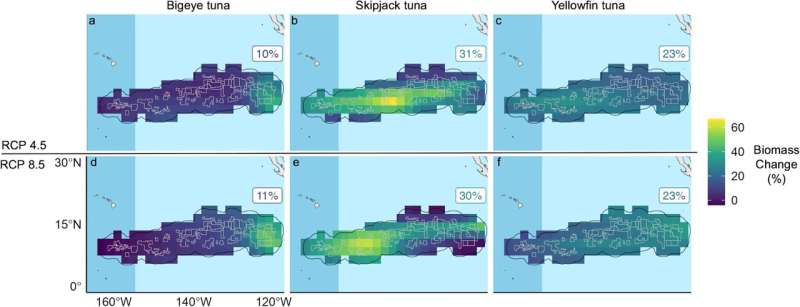July 13, 2023 report
This article has been reviewed according to Science X's editorial process and policies. Editors have highlighted the following attributes while ensuring the content's credibility:
fact-checked
trusted source
proofread
Deep sea mining plans could interfere with fish populations forced to move due to climate change

A team of marine biologists and oceanographers from the University of California, the University of British Columbia, the University of Hawaii and the South Atlantic Environmental Research Institute, has found evidence suggesting that fish such as skipjack, yellowfin tuna and bigeye have been changing their migration patterns due to climate change and have begun moving into areas where people plan to start deep sea mining.
In their paper published in the journal npj Ocean Sustainability, the group describes their work that involved studying the implications of deep-sea mining on marine life.
Over the past several years, as deep-sea technology has improved, various companies around the world have begun viewing the deepest parts of ocean floor as viable mining sites. Prior research has shown that sending down vessels capable of collecting polymetallic nodules (fist-sized rocks containing high concentrations of desired metals) should be viable, allowing for deep-sea mining. Such rocks have been found to harbor copper, cobalt, nickel, and manganese.
Proponents of such mining have suggested that conducting mining operations in areas where there is little life to disturb represents a "clean" type of mining. Most expeditions to the deepest parts of the oceans have found little evidence of sea creatures at the bottom. Still, others around the world have proposed that deep-sea mining be heavily restricted, or banned outright, because of the harm that could be caused to ecosystems that have not been very well studied.
Now it seems there may be a new wrinkle to the deep-sea mining proposal—the team with this new effort has found evidence that suggests many types of fish that until now have not migrated through or even too such areas, have increasingly been seen in such deep-sea areas.
The work by the team in this new effort involved studying wildlife in the Clarion-Clipperton Zone—a deep part of the Pacific Ocean, south-east of Hawaii. The 1.1m sq km parcel has been divvied up into pieces and doled out as contracts for deep-sea mining operations.
To assess the impact of mining in the area, the research team looked at total biomass in the area under climate change models scenarios. In so doing, they found it likely that bigeye, skipjack and yellowfish biomass would increase in the area by approximately 0 to 11%, 30 to 31% and 23%, respectively, by the middle of this century. They further suggest that mining the ocean floor at the same time would almost certainly disrupt the ability of such fish to survive.
More information: Diva J. Amon et al, Climate change to drive increasing overlap between Pacific tuna fisheries and emerging deep-sea mining industry, npj Ocean Sustainability (2023). DOI: 10.1038/s44183-023-00016-8
© 2023 Science X Network


















